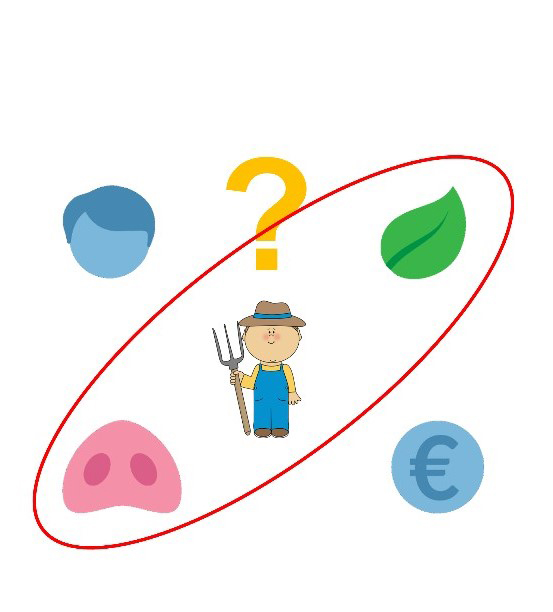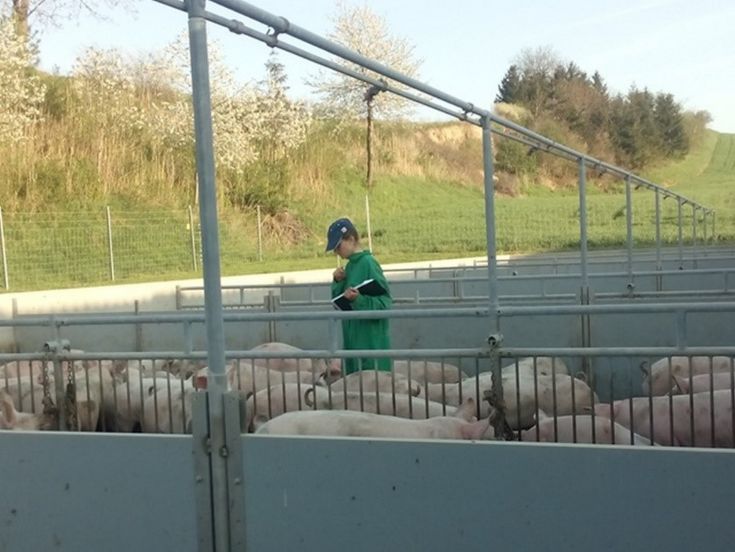Sustainable pig production systems - Investigation of synergies and trade-offs between animal welfare and environmental impacts
SUPERVISOR: Christoph WINCKLER
PROJECT ASSIGNED TO: Antonia Katharina RUCKLI
In the last decades, low producer prices and the need to increase efficiency has driven pig farming towards more intensive systems so that most of the pigs in the EU are kept nowadays in conventional husbandry systems. Conventional husbandry systems are mostly barren, with high stocking densities and do not meet the pigs’ behavioural needs regarding e.g. rooting, foraging, sleeping (Stolba and Wood-Gush, 1989) and maternal behaviour such as nest building (Jensen, 1986). In the meantime, awareness in society regarding animal welfare has increased, leading to stricter legal requirements (e.g. ban of sow stalls for pregnant sows, limitation of period in stalls during service and lactation) and the development of more animal welfare friendly husbandry systems (e.g. straw-based systems, systems with outdoor run). Moreover, livestock is widely regarded as having negative impacts on the environment from which pig supply chains are estimated to produce 0.7 billion mt CO2e per annum, accounting for 9 percent of the emissions from the global livestock sector (FAO, 2018). Especially feeding, efficiency and housing influence the extent of greenhouse gas (Philippe and Nicks, 2015) and ammonia emissions (Philippe et al., 2011). This framework poses enormous challenges to pig farmers across the EU.
As a result, farmer representatives are keen to investigate, how to improve animal welfare and reduce environmental load, whilst ensuring economic competitiveness as well as societal acceptance. All these four aspects are parts (“pillars”) of the concept of sustainability (Giddings et al., 2002; Schodl et al., 2017). A common difficulty is, however, that changes in one pillar of sustainability may influence other pillars. Higher animal welfare (e.g. more space, bedding) usually leads to more labor and higher production costs and can therefore have a negative impact on the overall economic performance of a farm (Bonneau et al., 2014). On the other hand, there can be strong correlation between the animals and worker’s health and welfare, e.g. caused by poor air quality (Porcher, 2010). The understanding of these synergies and trade-offs between pillars of sustainability is a crucial part for a sustainable development of pig farming systems.
The focus of this PhD lies specifically on the understanding of trade-offs and synergies between animal welfare and environmental impacts.

Figure 1: The four pillars of sustainability – farmer, environment, animal and economy. This PhD is focusing on the trade-offs and synergies between animal welfare and environmental impacts.
Research questions:
- To which extend do selected AHW improvement measures in current pig farming systems (e.g. more space, bedding) have an impact on the environment in terms of greenhouse gas and ammonia emissions as well as acidification potential and where do knowledge gaps exist?(based on literature)
- What are the key characteristics of pig farms in terms of environmental impacts based on a life-cycle assessment and key-performance indicators? (based on on-farm data)
- Is higher animal welfare related to environmental impacts in European pig systems?(based on on-farm data)
This PhD is part of the ERA-net SusAn project ”SusPigSys” (Sustainable Pig Production Systems), which aims to develop an integrative on-farm assessment- and feedback tool to provide a basis for pig farmers to improve their economic, environmental and societal sustainability, including animal welfare. For further information, please visit this website (https://suspigsys.fli.de/en/home/).

Figure 2: Assessing pigs (e.g. tail lesions, lameness) and resources on an Austrian farm.
Literature
Bonneau, M., T. N. Klauke, J. Gonzalez, L. Rydhmer, E. Ilari-Antoine, J. Y. Dourmad, K. de Greef, H. W. Houwers, M. U. Cinar, E. Fabrega, C. Zimmer, M. Hviid, B. van der Oever, and S. A. Edwards. 2014. Evaluation of the sustainability of contrasted pig farming systems: integrated evaluation. Animal 8(12):2058-2068. doi: 10.1017/S1751731114002122
FAO. 2018. Environmental performance of pig supply chains: Guidelines for assessment (Version 1). Livestock Environmental Assessment and Performance Partnership. Rome, FAO.:172 pp.
Giddings, B., B. Hopwood, and G. O'brien. 2002. Environment, economy and society: fitting them together into sustainable development. Sustainable development 10(4):187-196.
Jensen, P. 1986. Observations on the maternal behaviour of free-ranging domestic pigs. Applied Animal Behaviour Science 16(2):131-142.
Philippe, F.-X., J.-F. Cabaraux, and B. Nicks. 2011. Ammonia emissions from pig houses: Influencing factors and mitigation techniques. Agriculture, Ecosystems & Environment 141(3-4):245-260. doi: 10.1016/j.agee.2011.03.012
Philippe, F. X., and B. Nicks. 2015. Review on greenhouse gas emissions from pig houses: Production of carbon dioxide, methane and nitrous oxide by animals and manure. Agriculture, Ecosystems & Environment 199:10-25. doi: 10.1016/j.agee.2014.08.015
Porcher, J. 2010. The Relationship Between Workers and Animals in the Pork Industry: A Shared Suffering. Journal of Agricultural and Environmental Ethics 24(1):3-17. doi: 10.1007/s10806-010-9232-z
Schodl, K., F. Klein, and C. Winckler. 2017. Mapping sustainability in pig farming research using keyword network analysis. Livestock Science 196:28-35. doi: 10.1016/j.livsci.2016.12.005
Stolba, A., and D. Wood-Gush. 1989. The behaviour of pigs in a semi-natural environment. Animal Science 48(2):419-425.
